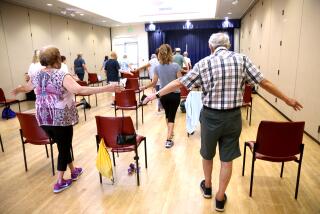We May Be Able to Push...
- Share via
While science strives to achieve the glamorous goal of increasing our life span, most researchers studying aging are concerned with a more practical problem.
Do we really want to live longer?
According to a group of researchers who study the consequences of being old, living longer might be of little value unless the extra years are healthy and active.
Despite recent gains in life expectancy caused by lower death rates from heart problems and other major fatal diseases, many of the nation’s elderly are troubled by generally nonfatal ailments and disabilities during their final years, gerontologists say. These conditions include Alzheimer’s disease, blindness, deafness, arthritis, osteoporosis, diabetes, hypertension, incontinence and physical frailty.
“These are the things that, for the most part, don’t kill us. But they make life difficult in old age,” says medical demographer S. Jay Olshansky of the Argonne National Laboratory in Illinois. “If you ask people what stops them from enjoying life in old age, many are going to say those diseases.”
Olshansky is co-author of a recent study published in Science magazine that asks if efforts to expand life should continue without equal emphasis on making the last years quality years.
Scientists have made astounding gains in the past decade in understanding the process of aging, giving rise to hopes that they might someday postpone its effects through genetic engineering.
Another arm of longevity research concerns eradicating the major killers--such as cancer and heart disease--to reduce death rates and prolong life. Advances in heart disease treatment have already led to gains in life expectancy over the past two decades, experts say.
But, Olshansky says: “What I worry about is if we are successful in identifying what causes us to age, if we find an anti-aging drug or find a way to manipulate genes, then we are faced with the social problem of whether we really want to do that.
“If we can extend life expectancy by 10 years or 20 years, we need to be assured that the additional years of life are healthy years. If we are adding 30 years of crippling disease, then I don’t think we should do it.”
The question is not merely philosophical. Policy-makers are increasingly interested in understanding the future impact on health care and Social Security as the baby-boom population turns the corner on middle age.
Experts estimate that the portion of the population age 65 and older will increase from 12% today to 22.9% in 2050. The number of Americans age 85 and older will increase from 3 million today to 16 million by the middle of the 21st Century.
Congress has allocated $323 million to the National Institute on Aging in Washington for fiscal year 1991 for new research and programs on aging, up nearly 30% from 1990--the largest percentage increase in funding this year among the federal health institutes.
“There hasn’t been that much funding for quality-of-life research in the last 20 years. But that’s beginning to happen now,” says Dr. Edward L. Schneider, dean of USC’s Andrus Gerontology Center. “The Medicaid bills, the health care bills, are going to drive us up the wall. So maybe we should start investing now in the quality of life.”
Shifting the emphasis in research from simply lengthening life to increasing years of health is the goal of a growing number of researchers. One reason, some say, is that we may be close to reaching the cap on how far we can push our life span.
In last month’s Science article, Olshansky and co-authors Bruce A. Carnes and Christine Cassel use statistics to show that even if the major fatal diseases were eliminated, life expectancy would not increase by much.
For instance, eliminating all forms of cancer, which cause about one-fifth of all deaths in the United States, would increase life expectancy at birth by only 3.17 years for females and 3.2 years for males.
Currently, U.S. females born in 1989 can expect to live until age 78.6, while males can expect to reach age 71.8.
“I think if our goal is (only) to increase life expectancy, then I don’t think we’re going to be very successful,” Olshanksy says. “Even if we go after major diseases, we’ll only make incremental gains.”
Moreover, he asks, even if cancer and heart disease were eliminated, would the elderly enjoy life if encumbered by weakened bones and muscles, dementia and hearing loss?
“The question is what are we replacing (death) with?” he says. “It is possible, as cancer and heart disease deaths decline, as we make this progress, that we may be about to trade longer life for worsening health.”
Already, medicine’s successful efforts to reduce deaths from heart disease and some types of cancer have raised questions about how to live with chronic illness, Olshansky says.
“Forty years ago, if you have a heart attack or stroke you wouldn’t live very long,” he says. “But science is rampantly transforming those diseases into chronic problems.”
Virtually no researchers advocate halting research on extending life span, either at the gene-tinkering level or among those working to cure the major fatal diseases. But with limited funds available for the study of aging, setting priorities for research becomes a sticky issue.
“I don’t think money should be taken away from cancer and heart disease,” Olshansky says. “Those are major contributors to morbidity and mortality. But we think it is now time to give equal attention to the other nonfatal diseases.”
In a 13-year study of elderly people completed in 1981, USC gerontologist Eileen M. Crimmins found that her subjects reported a wide range of disabilities marring their later years.
“Our conclusion has been that the increase in life expectancy has been in what we call ‘disabled years of life,’ ” she says. “The person says they have some kind of medical condition that prevents them from leading their normal life. But these appear to be conditions that might not be too serious. . . . For the most part, it’s mild disability.”
Nevertheless, because these conditions can hamper one’s ability to enjoy life, researchers are seeking ways to eliminate them. Crimmins is optimistic that this is possible, as the emphasis in health care moves from treating diseases to preventing them.
Studies have shown that a good diet, stress reduction, aerobic and weight-bearing exercise and companionship can help the elderly stave off chronic ailments and remain active and happy.
“I think that’s where much more research is being concentrated: delaying the onset of disease,” Crimmins says. “We’ve just arrived at the idea that elderly people can be rehabilitated” after injury or surgery.
But in setting priorities for research on aging, society should not attempt to determine just what kind of life is worth extending, says Richard Suzman, a scientist at the National Institute on Aging.
“I think it’s important to realize that, while we all have a sense of what quality of life means, ultimately it’s a very subjective measure that differs across groups and individuals,” he says.
Before deciding to fund expensive scientific research, he adds, federal health officials must weigh the potential benefits of the research against the costs. But, Suzman says that it would be wrong to stop pursuing longer life expectancy based on the belief that those extra years would not be worth living because of pain, disability or dementia.
“I think that one could make a bad mistake if we adopted some federal (standard) that defines quality of life.”






